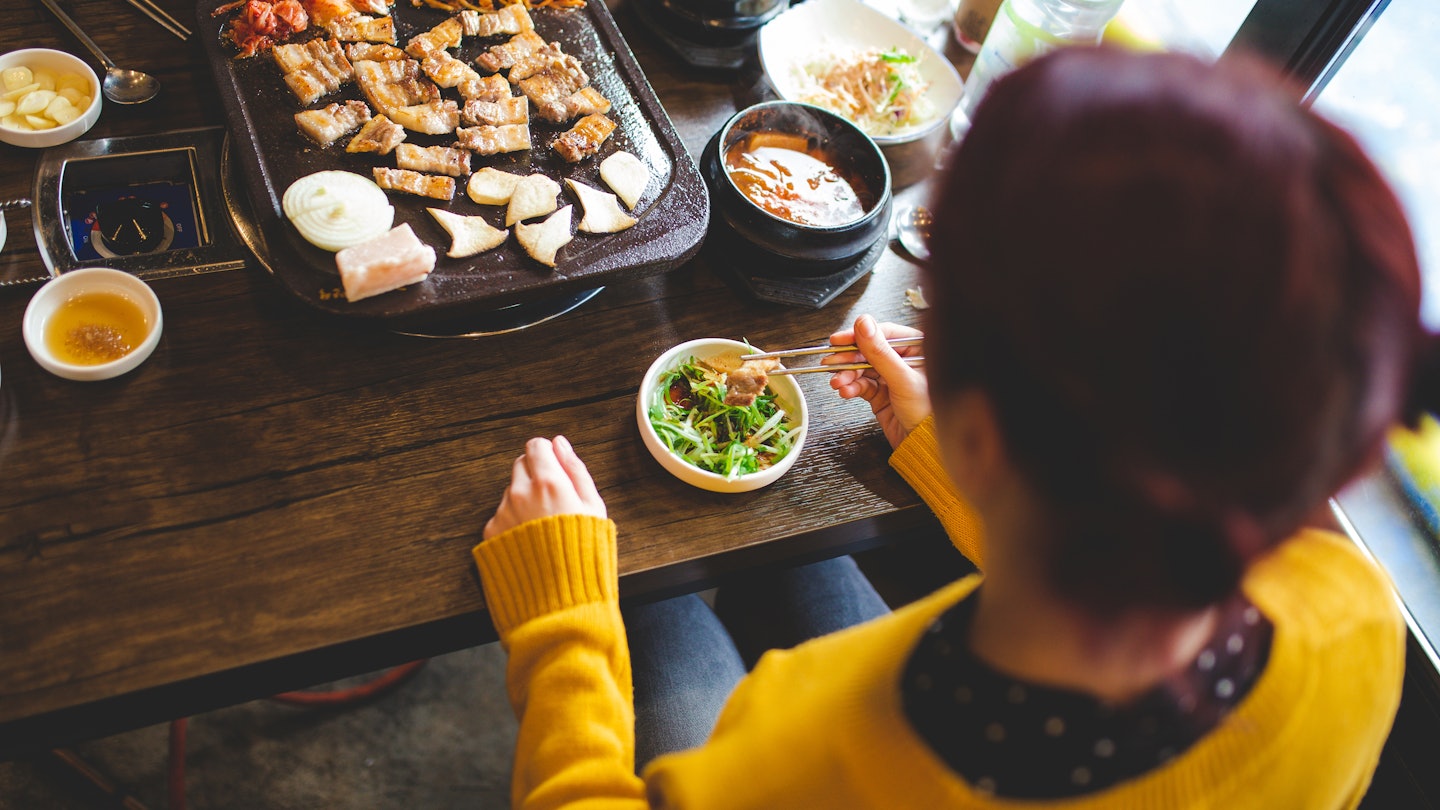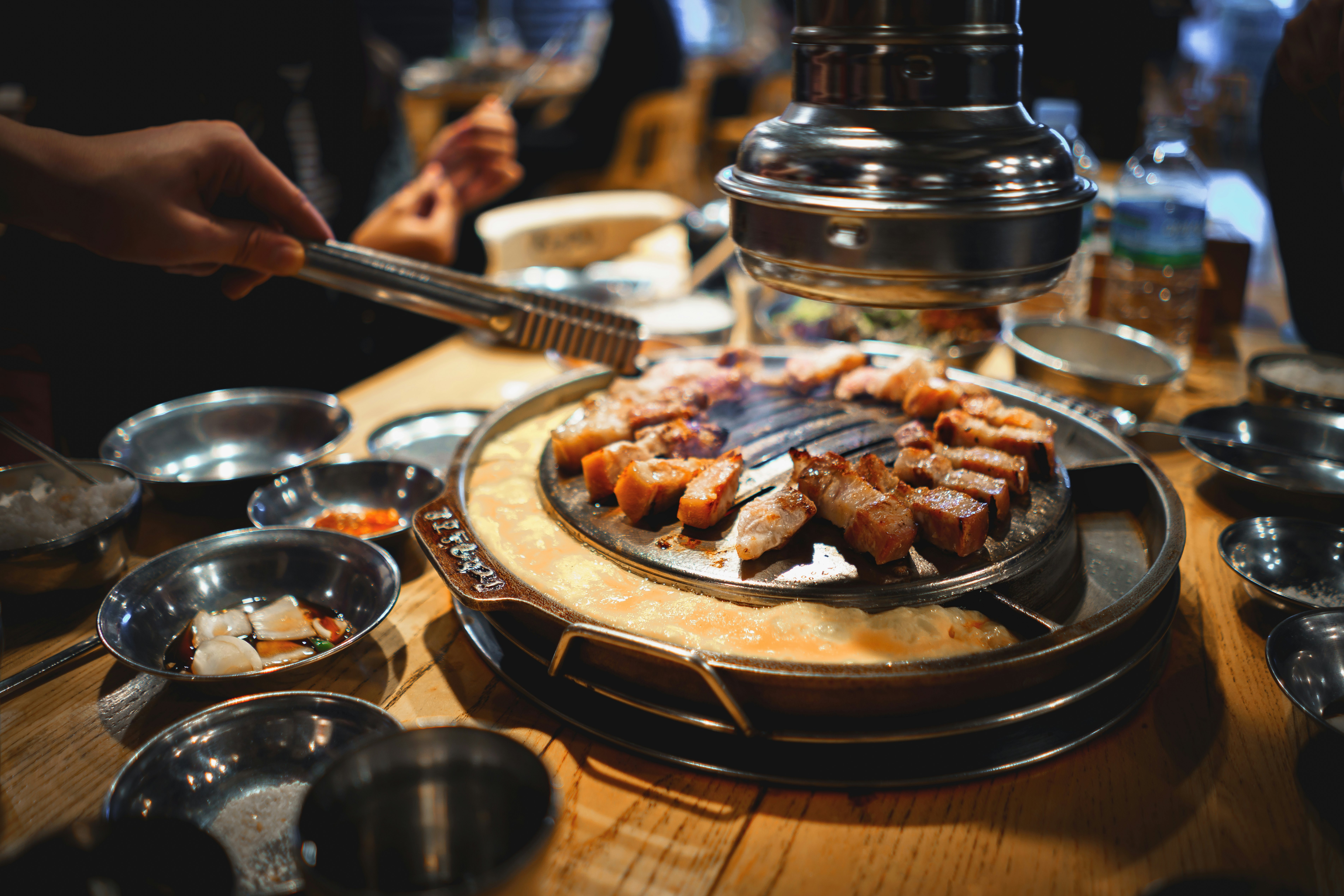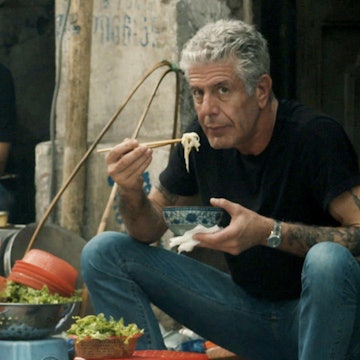
All the best places to eat in Seoul, a foodie’s playground


From traditional eats to high-end fare, Seoul is a foodie’s dream © Kosamtu / iStock / Getty Images
Just like Seoul itself, the South Korean capital’s culinary scene brings together the best of the entire country – and beyond.
Foodies will find restaurants serving regional recipes from the provinces, neighborhood markets slinging nostalgic snacks, high-end chefs innovating with local and international flavors and young restaurateurs bringing passion to independent pubs and patisseries.
Whether you’re after Michelin-starred cuisine or just something cheap and filling, Seoul has something for every kind of craving. Here are Seoul’s must-visit restaurants.
Discover 30+ top Seoul attractions all on one pass with Go City. Pick between a 1 to 5- day All-Inclusive Pass and brave the thrill rides at Lotte World, visit the border on a Demilitarized Zone Tour, enjoy the views from N Seoul Tower, and much more!
Best cheap eats in Seoul
For a cosmopolitan metropolis, Seoul is an easy place to eat on the cheap – as long as you stick to Korean food. Fierce competition keeps prices reasonable, and culinary tradition means that side dishes are always both free and bottomless. Low prices do not equate to bad food: you can eat very, very well for just a few thousand won, a blessing at a time when travel costs have spiked.
Diving into South Korea’s hole-in-the-wall restaurants
Savor the stews at Ttukbaegi-Jip
Tucked on a back street just south of the popular Insa-dong neighborhood, humble Ttukbaegi-Jip has been dishing out homely Korean stews and meals for decades. For only ₩6000–7000, you’re served your choice of stew, rice and an array of homemade side dishes like mixed soybean sprouts and sauteed zucchini. Eat them separately or mix them together to make bibimbap – and top it off with the homemade gochujang (red pepper paste) on every table.
Tteokbokki’s the thing at Kokkiri Bunsik
Tteokbokki (rice cakes cooked in a spicy and sweet gochujang-based sauce) is a classic Korean snack. Near Mapo Station, Kokkiri Bunsik offers a no-frills, table-side variety where you can customize your basic tteokbokki with hard-boiled eggs or glass-noodle-filled fried dumplings. Tteokbokki for two starts at just ₩2500, with add-ons each costing just one or two thousand more.
Hail a ride to Songlim Sikdang
Originally used by taxi drivers because they were fast and cheap, “taxi restaurants” are now popular dining spots for everyone. Only a couple of blocks from Konkuk University, Songlim Sikdang is one of Seoul’s largest taxi restaurants, with more than 300 seats. The soups and stews here are all inexpensive – just ₩7500 – and come with rice and side dishes. A favorite menu option is the marinated pork (₩9000), which comes in a large broth-filled pan for you to cook at your table.
Yoojin Sikdang is a longtime stalwart
Though much has changed in the Jongno neighborhood – new skyscrapers have risen, and old homes have become trendy cafes – decades-old Yoojin Sikdang remains the same. Its Pyongyang-style naengmyeon (a cold noodle dish), bindaetteok (mung bean pancakes), soups and stews are some of the cheapest around town, ranging from ₩6000 to ₩15,000 – so expect a crowd at this eatery on the north side of historic Tapgol Park.
Best high-end dining in Seoul
Seoul chefs are working hard to elevate the level of the city’s haute cuisine. Many of Seoul’s most exciting talents have trained internationally and play at combining Korean and Western cuisines and techniques, while others are finding ways to take humble traditional recipes to new heights. With hansik (Korean food) now popular worldwide, it’s an exciting time to taste how it’s being elevated in its birthplace.
Enjoy elevated Korean preparations at Poom
Poom takes traditional gourmet Korean dishes and reinterprets them with a modern twist. The seasonal menu means the chefs here use only the best ingredients. Its meat and seafood dishes, such as the grilled and marinated beef, are standouts and akin to what would have once been served to Korea’s royalty. The restaurant is located in the posh Cheongdam neighborhood, the playground for movie stars, K-pop idols and other members of Seoul’s glitterati – which is why lunches come in at around ₩200,000, and dinners ₩300,000.

Korean and Western flavors combine at Mingles
As its name suggests, this fine-dining establishment in the Apgujeong neighborhood aims to “mingle” the flavors of Korean and Western cuisines. Traditional Korean ingredients such as soybean paste and mugwort are married beautifully and unexpectedly with lamb and crème brûlée, pushing modern Korean cuisine into new territory. The nine-course lunch menu is around ₩150,000, while the 11-course dinner menu costs ₩250,000.
Toc Toc will surprise your taste buds
With ingredients and flavors from a variety of cuisines, it’s hard to put a label on Toc Toc. Familiar dishes such as pasta, terrine and steak take on unexpected flavors, while signature dishes like the truffle dumplings have to put the Gangnam District hotspot on the foodie map. With tasting menus starting at just ₩90,000 for weekday lunch, Toc Toc is also a relatively affordable place to sample haute cuisine in Seoul.

Best vegan and vegetarian restaurants in Seoul
South Korea can sometimes be a tough place for vegetarians and vegans to navigate. These diets aren’t widespread in the country, and many foods that seem to be plant-based actually include ingredients like anchovy broth or salted shrimp. Thankfully, it’s less tough than it used to be, and Seoul in particular is home to numerous places offering plant-based menus.
Plant Cafe serves up international vegan fare
One of the first vegan restaurants in Seoul to offer plant-based options beyond Korean cuisine, Plant Cafe, with locations in Itaewon and Yeonnam, offers tasty vegan bowls, veggie burgers and wraps, most priced between ₩10,000 and ₩15,000. Its vegan drink options include everything from smoothies and cold-pressed juices to teas and kombucha. The vegan bakery serves up cakes, cookies and other tasty baked treats.
The food has a Buddhist twist at Sanchon
Korea’s Buddhist vegetarian cuisine has gained international exposure in recent years. Aside from visiting a temple, dining at Sanchon is one of the most popular ways to sample this unique fare, which omits ingredients such as garlic and chives.
Located in the Insadong neighborhood, Sanchon was established by a former Buddhist monk with a focus on seasonal ingredients and traditional methods of preparation – and its humble setting and colorful plate presentation have made the place a hit. Lunch and dinner set menus are both ₩33,000, with traditional Korean music and dance performances taking place in the evenings.
Vegan fare goes upscale at Balwoo Gongyang
Despite its modern setting, Balwoo Gongyang’s menu is filled with traditional Korean Buddhist dishes that refrain from meat and certain roots such as shallots and leeks. The homemade sauces and pastes are paired with the freshest of seasonal ingredients to create well-balanced dishes like pumpkin-and-millet porridge and deep-fried mushrooms with gochujang sauce. Tasting menus range from ₩30,000 to ₩150,000.
Fuel up in between rounds at Drunken Vegan
As the name suggests, Drunken Vegan restaurant and bar is perfect for those looking for some vegan snacks and food to go with a nice selection of drinks. The vegan lasagna and vegan fish-and-chips, both ₩18,000, are crowd-pleasers. Typically of the Hongdae neighborhood, the space is cozy, yet the atmosphere is casual and socially forward. The restaurant/bar is LGBTQI-friendly, and shares space with an adult store.
How to party in Korean convenience stores

Best Korean barbecue in Seoul
Korean barbecue is one of the most fun eating experiences you’ll find anywhere in the world. Cooking pork belly or beef ribs at your table, combining the sizzling meat with a myriad of side dishes so that every bite is different, then washing it all down with ice-cold beer or soju: it’s no wonder this is the preferred meal for a night out with friends, for Koreans and visitors alike.
Get a taste of Gangwon-do at Ogeunnae Dak Galbi
Tender cuts of chicken in a sweet-and-spicy marinade are cooked to juicy perfection at the famous Ogeunnae Dak Galbi, located in the Yongsan District. This restaurant is the best place (apart from the Chuncheon region, where the dish originated) to eat the popular dak galbi (chicken and vegetables stir-fried in a red pepper paste-based sauce). (One order is ₩14,000.) Eat the chicken and veggies on their own, or pair them with a bowl of cold buckwheat noodles for ₩8000 for the ultimate Gangwon-do Province dinner.
You’ll find the beef at Daedo Sikdang
Started in 1964, Daedo Sikdang is a Korean barbecue institution. At the original branch near Wangsimni Station (and Seoul’s largest meat market) as well as at branches in the Sinsa and Mapo neighborhoods, you’ll hear the sizzle of the well-marbled hanwoo (Korean beef) sirloin cooking in the restaurant’s trademark cast-iron pan. This is high-quality beef, with a price tag to match – an order of the sirloin will set you back a hefty ₩46,000. Forget dessert and cap off your meal by ordering the famous kkakdugi-bokkeumbap – diced radish kimchi and rice stir-fried to perfection in beef renderings.
The protein comes from the sea at Getbeol Eui Jinju
This lively restaurant chain grills fresh seafood such as scallops, clams and shrimp right at your table. If you don’t feel like barbecuing, opt to have your seafood steamed or cooked together in a soup. With sauces on the side, it’s a nice break from the common barbecued meat. Plan on a bill between ₩30,000 and ₩70,000.
Impress your date at Maple Tree House
This upscale chain of Korean barbecue restaurants is a good option when you’re looking to impress. Watch as prime cuts of meat – including Jeju-do black pork belly (₩19,900) and aged hanwoo strip loin (₩49,500) – are expertly cooked at your table. Dishes like bibimbap (rice with meat and cooked vegetables), kimchi stew and cold noodles can be enjoyed on their own or added to your barbecue meal. The original Maple Tree House is located in the leafy Samcheong neighborhood; you’ll also find branches in Itaewon and Gangnam.

Best traditional marketplaces in Seoul
Wherever you travel, traditional markets are the best place to go for authentic flavors on the cheap. And Seoul has some great ones, where locals and tourists alike come to fill up on noodles, street snacks, seafood and lots, lots more.
Try Namdaemun Market for noodles and fish stew
This sprawling market complex next to Namdaemun Gate has a number of notable food alleys. One is the alley for kalguksu (knife-cut noodles), where patrons get free bibim naengmyeon (cold noodles in a spicy-sweet sauce) and kalguksu with any order of bibimbap.
For something you’ll likely be hard-pressed to find outside Korea, try the alley specializing in braised hairtail fish, where the specimens are cooked to tender perfection in a traditional pot filled with radish and a spicy-sweet sauce. Other popular snacks around the market include fist-sized handmade dumplings and hotteok – fried mini cakes filled with a choice of a sweet or savory filling.
Eat your way through Gwangjang Market
One of the nation’s oldest traditional markets, Gwangjang Market is a vast downtown complex known for selling a variety of tasty and cheap food. Some popular eats here include kkoma kimbap (small seaweed rolls dipped in a mustard soy sauce) and yukhoe (beef tartare). Gwangjang is most famous for its bindaetteok, fried mung-bean pancakes that are soft on the inside and crispy on the outside. They’re perfect when paired with a bottle of makgeolli, a cloudy unrefined rice wine.
Build your own lunch box at Tongin Market
Small and traditional, Tongin Market, in the old Seochon neighborhood west of Gyeongbokgung Palace, has quickly become a draw for its unique build-your-own lunch box system. After paying a small flat fee of ₩5000, you’ll receive a compartmentalized lunch tray with some old traditional coins. As you walk around the market, picking out what you want, a vendor will place the food onto your tray and take the number of coins it costs. Repeat until you run out of coins. Be sure to try the gireum tteokbokki (tteokbokki that’s stir-fried in oil), a market specialty.

If you love fish, you can’t miss Noryangjin Seafood Market
The seafood offerings at Noryangjin, Seoul’s largest fish market, are some of the most diverse and fresh you’ll find. As you browse the different vendors to see what’s available, your haggling skills will be useful here. You should also (politely) ask whether the vendor is willing to throw in a few freebies. Once the seller completes the initial seafood preparation, you’ll likely be directed to an associated restaurant where you can have your freshly purchased seafood prepared just the way you like. The restaurant will apply a small service charge in addition to what you paid for your fish.
Best free things to do in Seoul
Best noodle restaurants in Seoul
There’s nothing as satisfying as a good bowl of noodles, an essential element of Korean cuisine. And Seoul has no shortage of places to slurp them up, in every variety from hot noodle soups and Chinese-influenced black-bean sauce noodles to cold North Korean noodles in a chilled broth.
Myeongdong Kyoja specializes in knife-cut noodles
In operation since 1966, Myeongdong Kyoja in the eponymous Myeongdong neighborhood, specializes in kalguksu, knife-cut noodles topped with stir-fried vegetables and meat in a savory chicken broth. While kalguksu is usually made with seafood or beef broth, the dish here has a slight smoky yet light flavor, and its signature kimchi is a garlic-lover’s dream come true. Steamed dumplings and a popular cold mixed noodle are also on the menu. All dishes are in the ₩10,000 range.
Try Younghwaru if you like your noodles spicy
Located in the Seochon neighborhood, Younghwaru has been around for more than half a century. The Chinese-influenced dishes of jjajangmyeon (noodles with meat and vegetables cooked in a black bean sauce) and jjamppong (noodles in a spicy seafood broth) are favorites of Koreans, and Younghwaru’s spicy versions are Seoul classics. Both dishes include a generous amount of chopped Cheongyang peppers, a Korean chili pepper known for its heat. A bowl of jjajangmyeon here costs ₩7000, while jjamppong is ₩8000.
Wooraeok offers Pyongyang-style noodles
The soothingly bland dish Pyongyang naengmyeon (cold buckwheat noodles) takes on new life at Wooraeok, near Euljiro-4-ga Station. A distinct and robust beefiness has made its Pyongyang naengmyeon (₩16,000) a year-round favorite for locals since the spot opened in 1946. Pair the dish with cooked bulgogi beef to experience a truly winning meal.
You might spot a celebrity at Jinju Hwoegan
One of Korea’s most famous places for kongguksu (noodles in a cold soybean broth), Jinju Hoegwan has served everyone from politicians and business leaders to celebrities. Sourced from Gangwon Province, all the beans in the soybean soup are of the best quality, forming part of a secret recipe that gives the broth its extra nutty taste. Even the dough for the noodles differs from others thanks to ingredients such as potato starch and ground nuts, which are added for extra flavor and elasticity. Jinju Hoegwan is located near City Hall station. A bowl of kongguksu is ₩13,000.















